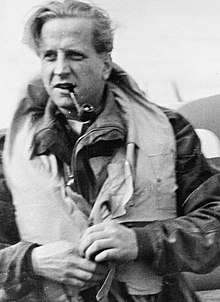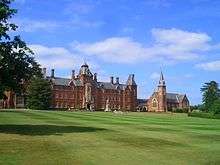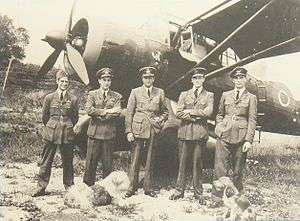Percy Charles Pickard
| Percy Charles Pickard | |
|---|---|
 P. Charles Pickard | |
| Nickname(s) | "Pick" |
| Born |
19 May 1915 Handsworth, Sheffield, West Riding of Yorkshire, England |
| Died |
18 February 1944 (aged 28) Amiens, France |
| Allegiance | United Kingdom |
| Service/branch | Royal Air Force |
| Years of service | 1937–1944 |
| Rank | Group Captain |
| Commands held |
No. 140 Wing RAF No. 51 Squadron No. 161 Squadron |
| Battles/wars | Second World War |
| Awards |
Distinguished Service Order & Two Bars Distinguished Flying Cross Czechoslovak War Cross 1939 Mentioned in Despatches |
Group Captain Percy Charles "Pick" Pickard, DSO & Two Bars, DFC (16 May 1915 – 18 February 1944) was an officer in the Royal Air Force during the Second World War. He served as a pilot and commander. He was the only officer of the RAF awarded the DSO with two bars in the Second World War. He flew over a hundred sorties and distinguished himself in a variety of operations requiring coolness under fire. In 1941 he participated in the making of the 1941 wartime film Target for To-night, which made him a public figure in England. He led the squadron of Whitley bombers that carried paratroopers to their drop for the Bruneval raid. Throughout 1943 he flew the Lysander on nighttime missions into occupied France for the SOE, performing insertions of agents and picking up personnel from very small landing strips. Pickard lead a group of Mosquitos on the Amiens raid, in which he was killed in action 18 February 1944.
Early life

Charles was born at 82 Main Road, Handsworth, Sheffield, on 16 May 1915, the youngest in the family of two sons and three daughters of Percy Pickard, stone merchant, and his wife, Jennie Skelton. Pickard was born in Handsworth, Sheffield, in the West Riding of Yorkshire, England, the son of Percy Charles Pickard and his wife Jenny. He was the youngest of five children, with an older brother and three older sisters. His father, a Yorkshireman, was a stone merchant. In 1920 the family moved to Hampstead, London, where Pickard's father began a successful catering business. Having the same name as his father and being the youngest in the family, he was affectionately referred to as 'Boy', and the family nickname persisted, even as he grew to be 6' 4".[1] He was sent to Framlingham College.[2] His older brother, Walter, joined the RAF and became an officer. His oldest sister "Pixie", Helena Pickard, became an actress. She married well known actor Sir Cedric Hardwicke.[2] Though bright and engaging, Pickard struggled with both reading and writing, leading some to believe later that he may have struggled with dyslexia.[3] He was enthusiastic in school sports, and excelled at shooting, but by far his favorite activity was riding horses.
The father of one of Pickard's schoolmates at Framlingham owned a farm in Britsh East Africa, and offered his son to bring a classmate along when he came out to work on the farm once they graduated from college. Pickard took up the offer, and arrived in Britsh East Africa in 1932.[4] The schoolmate returned after a couple of years but Pickard choose to stay on. The vast grasslands provided ample opportunity for riding, and Pickard excelled as a Polo player, earning a 3 handicap.[3] In November 1935 he joined the King's African Rifles as a territorial reservist.[4]
With the gathering dark clouds of war looming, Pickard and two of his friends chose to return to England. Lacking the funds for a full passage, they drove their car north through Italian Somaliland, British Somaliland, Egyptian Sudan, finally arriving in Egypt. Along the way Pickard became ill with Malaria and they had to stop for some time, but the group eventually made it to Alexandria from which they obtained transport back to England.[3] Once he arrived he volunteered to serve as an officer with the Army, but was declined on account of his poor school results. He then applied to the Royal Air Force, who were in the midst of a massive expansion. He was granted an RAF short service commission in 1936. After initial flying training he was posted to 214 Squadron, equipped with the Handley Page Harrow bomber.[3] He received a commission as Acting Pilot Officer 25 January 1937.[5] The posting of Pilot Officer was confirmed and made permanent 16 November, 1937.[6] He was posted to Bomber Command.[4] During this period he met and began seeing Dorothy Hodgkin. Her family did not approve of the couple, but they wed anyway. His wedding present to her was a large Old English Sheepdog to keep her company while he was away. They called the dog 'Ming'.[1]
Pickard trained with 214 Squadron for a short time before being appointed ADC to Air Vice Marshall John Baldwin in 1938, who was commander of the training group at Cranwell.
1st Tour with 99 Squadron

On 30 October 1939, Pickard was posted to 7 Squadron flying Hampden bombers at RAF Upper Heyford.[3] Shortly thereafter he was returned to 214 Squadron. This squadron was disbanded to form an operational training unit, and he briefly returned to 7 Squadron before being posted to 99 Squadron at Newmarket Heath. He remained with 99 Squadron through the first year of the war, flying one of the best bomber aircraft available at the time, the Vickers Wellington.[7]
In the early stages of the war prior to the German invasion of France Bomber command was reticent about escalating the war by launching major attacks on German cities. Instead they confined their command to leaflet drops and coastal patrols. With the German invasion of Denmark and Norway the command became more active. Flying Whitley bombers with 99 Squadron, Pickard participated in fighting over Norway, France and during the Dunkirk evacuation. He was awarded the Distinguished Flying Cross (DFC) in July 1940.[2]
Bomber Commands early daylight raids deeper into Germany revealed that the defensive armament of the bombers was inadequate to defend them against German fighter aircraft. Stanley Baldwin's axiom “The bombers will always get through” was proven false. After suffering significant losses the heavy bombers were withdrawn from daylight attacks. Both the British Army and the Royal Navy were desperate for aircraft to help them in their respective endeavors, and bomber command's strength was attenuated as aircraft were shifted away to the Navy to help with submarine patrols, and to the Army to help in the Western Desert. Bomber Command, still convinced that "Strategic Bombing" was a war winning strategy, moved its bombing campaign against Germany to night missions. Though much safer to the aircrews, flying at night eliminated many of the visual clues to navigation, making it much harder to find and attack the target. Foul weather could cloak targets as well, and the industrial Ruhr valley area generated enough haze from its factories to keep the region in a constant shroud of fog. England's notorious bad weather also added to the danger, making finding and setting down on the home airfield significantly more dangerous. Bomber Command lacked navigational abilities, and the results of the raids were unknown to the crews.

Navigational techniques slowly improved, crews became better, as did German night defenses.[7] As navigation improved so did their ability to reach and deliver bombs on target. It was during this period that Pickard met and befriended fellow Yorkshireman navigator Alan Broadley, who was to become his good friend and comrade to the end.[8] Thereafter when Pickard transferred to an operational squadron he would always ask for Broadley to be transferred into the squadron as well. Pickard was calm when under duress, and gained a reputation for striking at his objective and pressing on regardless of apparent difficulties. Aircraft service crews grew accustomed to Pickard and Broadley returning in an aircraft that had been peppered with flak and night fighter damage.
Through the campaign in the air Pickard had settled down to a fairly comfortable life living on base with his wife Dorothy and their English Sheepdog ‘Ming.’[7] With horse racing suspended because of the war, Pickard was able to acquire two former race horses at low expense.[7] Whether he had flown the night before or not, each morning would find Pickard out for a ride in the country, with Ming running alongside.
In one of these nighttime missions, 19 June 1940, the squadron attacked the Ruhr. Pickard's Wellington was hit by anti-aircraft fire and one engine was seriously damaged. Loosing altitude, he was able to nurse the aircraft past the coast but ended up having to ditch in the North Sea. The crew escaped alive and all entered a rubber dinghy. After a number of hours they were located by an RAF rescue launch. Unfortunately, Pickard had set down in mine field. It took many more hours for them to drift out of the mine field so they could be picked up by an RAF High Speed Launch from Felixstowe.[3]. In all they spent 14 hours in the bitter cold of the North Sea.[8]
The most common complaint from aircrews involved in the RAF's bomber campaign against Germany was of exhaustion from the stress of both the missions themselves and from trying to take off and land at night in England’s notorious bad weather. Pickard never seemed troubled by this. No record of Pickard or Broadley notes either ever complaining of exhaustion.[7] By the end of November, Pickard and Broadley had completed 31 sorties, and were rotated off to non-operational duties. Pickard, however, was soon looking for a means of getting more operational flying in.[7]
Pilot instruction of 311 (Czech) Squadron
He proved to be a patient instructor, who remained dogged in his determination to reach the target. He was promoted to the rank of Squadron leader, and often rode along with his Czech aircrews on their missions into Germany. He was later awarded the Czech medal for his work with the squadron.

With the completion of his first tour he was promoted to Squadron leader and transferred to a training position, working to train pilots in the No. 311 (Czechoslovak) Squadron, operating out of RAF East Wretham. 311 Squadron was not-fully operational. Most of their flights were coastal patrol missions, but as part of the training process from time to time the crews were sent along with combat squadrons on missions over Germany. Pickard proved a hard task master and persistent instructor, often joining his pupils in the cock-pit as co-pilot in their flights into Germany. On September 24 the squadron carried out its first operation to the ‘Big City’ (Berlin).[3] As he was a "ride along" instructor, these sortie flights were off the book and did not add to Pickard’s sortie totals. Language problems between Pickard and his Czech charges was an issue. He decided to concentrate his efforts on those pilots with the most experience flying. An interpreter told him of one Czech named Joe with 2000 hours flying experience. Pickard turned his attention to him. After several trips the man was still a strangely inept pilot for a man with 2000 flying hours under his belt. Upon further questioning of the interpreter Pickard discovered that the individual was actually a navigator, with no piloting experience at all. Undeterred, Pickard pressed on training Joe as a pilot anyway.
At this time Crown Productions was doing a movie on the bomber campaign. Pickard was an experienced pilot available, and had acting in his family. He was asked to play the pilot for the production of Target for To-Night, and became widely known as the pilot of the bomber “F-Freddie”.[7] The movie was a success, and made him a national hero.[1][9] Upon completion of the film in April 1941, Pick returned to operations.[3]
For his service with 311 Squadron he received his first Distinguished Service Order (DSO) in March 1941.[2] He was also awarded the Czech Cross.[1]
2nd Tour with 9 Squadron

On 14 May 1941 Pickard was assigned to 9 Squadron. He was joined there by Broadley, who by now had become a commissioned officer. The squadron was based at Honington, and flew the Wellington. Another grueling tour of operations followed. In the night skies over Germany in the summer of 1941 they flew against major German targets such as Hamburg, Düsseldorf and Cologne.[10] At the time, only about 30% of aircrews survived to the end of a 30 sortie tour of combat. By the end of August Pickard had flown another 33 sorties with Broadley, bringing his total to 64. This number did not include those missions he flew with the Czechs. Crews who had completed two tours of 30 were considered to have “done their part”, and were rotated to non-combat roles.[7]
With the end of his second tour Pickard was rotated off again. He was assigned 3 Group Headquarters as a shuttle pilot flying senior command officers between airbases, but took no pleasure in such service.[7] Having completed two operational tours, Pickard and Broadley had fulfilled their operational requirements, and need not have done any more operations. But again, he talked his way back into an operational unit.
51 Squadron
In May 1942, as wing commander in charge of No. 51 Squadron, he was awarded a bar to the DSO in recognition of his leadership in Operation Biting (also known as the Bruneval raid) on 27 February 1942. In March 1943, while commanding No. 161 Squadron – which carried out operations in support of the SOE in occupied Europe – at RAF Tempsford he was awarded a second bar to the DSO for outstanding leadership ability and fine fighting qualities.[11] He was the first RAF officer in the Second World War to be awarded the DSO and two bars.[12]

For a while Pickard was station commander at RAF Sculthorpe. In October 1943 he was given command of No. 140 Wing of the Second Tactical Air Force by Basil Embry. This put him in charge of three squadrons of de Havilland Mosquito fast bombers. They became specialised in low level precision attacks.[13]
Pickard led the February 1944 low-level attack on the Amiens Prison, in the raid known as Operation Jericho. The attack was carried out at the request of the French resistance in order to allow a considerable number of their imprisoned members, who were soon to be executed by the occupying Nazis, the chance to escape. The Resistance stated that the prisoners had said they would rather take the chance of being killed by RAF bombs than be shot by the Nazis. Operation Jericho was a success but Pickard, together with his Navigator, Flight Lieutenant J. A. "Bill" Broadley, were killed when their Mosquito, HX922/"EG-F", was shot down by a Fw 190 flown by Feldwebel Mayer of 7. Jagdgeschwader 26 in the closing stages of the operation. Pickard and Broadley were initially reported missing and then in September 1944 it was announced that they had been 'killed in action'.[14]
Pickard is buried in plot 3, row B, grave 13 at St. Pierre Cemetery near Amiens, France.[15] Broadley is buried in plot 3, row A, grave 11 of the same cemetery. Pickard was married at the time of his death.[14]
The French government called for him to receive a posthumous Victoria Cross.[16]
References
Notes
- 1 2 3 4 Fraser, Katie Battling for the honour of a wartime hero Daily Express 7 April 2004
- 1 2 3 4 The Times, 22 September 1944 (page 7 issue 49962)
- 1 2 3 4 5 6 7 8 Coxon, David (19 May 2016). "Brave Percy was the Wartime Pick of the RAF Bunch". Bognar Regis Observer. Retrieved 1 August 2017.
- 1 2 3 "Pickard, Percy Charles". World War 2 Awards. Retrieved 1 August 2017.
- ↑ "No. 34369". The London Gazette. 9 February 1937. p. 895.
- ↑ "No. 34457". The London Gazette. 23 November 1937. p. 7352.
- 1 2 3 4 5 6 7 8 9 Orchard, Adrian Group Captain Percy Charles “Pick” Pickard DSO**, DFC 1915 - 1944 February 2006
- 1 2 Sedgwick, Philip (17 February 2017). "Leyburn RAF ace Alan Broadley died on mission to save others". Darlington and Stockton Times. Retrieved 1 August 2017.
- ↑ Crowther, Bosley (18 October 1941). ""Target for Tonight", a Fine Fact Film About the R.A.F., at the Globe -- Comedy at Central". New York Times. Retrieved 12 August 2017.
- ↑ "Broadley, John Alan". World War 2 Awards. Retrieved 1 August 2017.
- ↑ "No. 35954". The London Gazette (Supplement). 23 March 1943. p. 1413.
- ↑ K. R. M. Short, ‘Pickard, Percy Charles (1915–1944)’, Oxford Dictionary of National Biography, Oxford University Press, September 2004; online edition, May 2008, doi:10.1093/ref:odnb/62384. Retrieved on 5 November 2008 Archived 13 February 2011 at WebCite
- ↑ Heroes of the Skies Michael Ashcroft
- 1 2 "Deaths". Issue 49962; col D. The Times. 22 September 1944. p. 7.
- ↑ Casualty details—Pickard, Percy Charles, Casualty details—Broadley, John Alan, Commonwealth War Graves Commission. Retrieved on 5 November 2008. Archived 13 February 2011 at WebCite
- ↑ 'Operation Jericho', BBC (TV), 20 October 2011
Bibliography
- Mosquito at War by Chaz Bowyer – Ian Allen – 1977 – ISBN 978-0-7110-0474-0
- Armstrong Whitworth's Night Bomber by Ray Williams – Aeroplane Monthly – October 1982 issue.
- Royal Air Force A/Group Captain Percy Charles Pickard, Obituary. The Times, 22 September 1944.
External links
- Percy Charles Pickard
- Percy Charles Pickard at Find a Grave
- Group Captain Percy "Pick" Pickard pictured while resting from operations as Station Commander at RAF Lissett